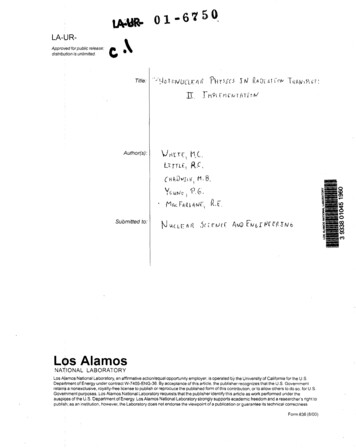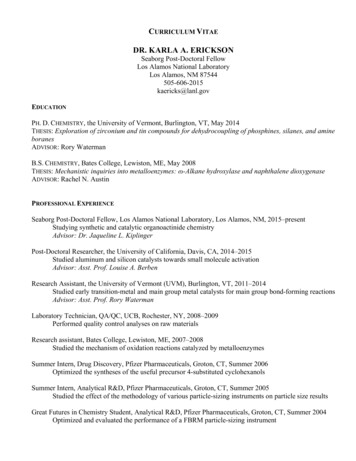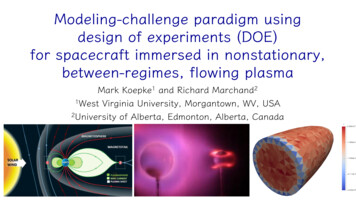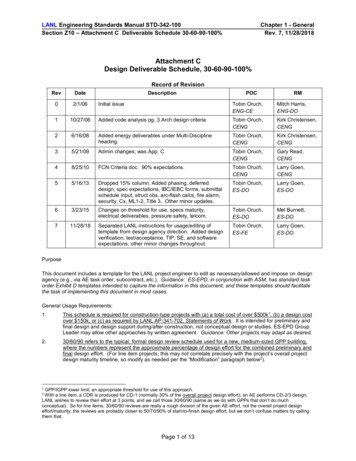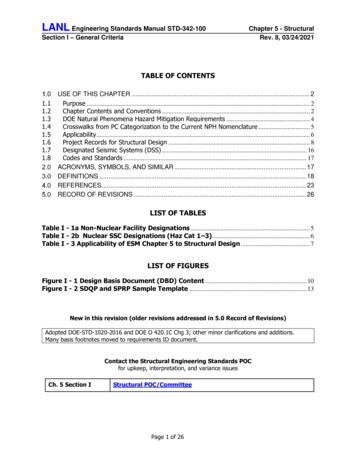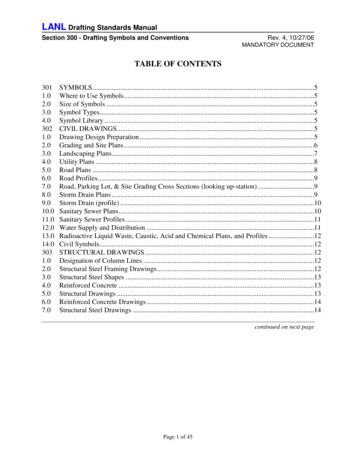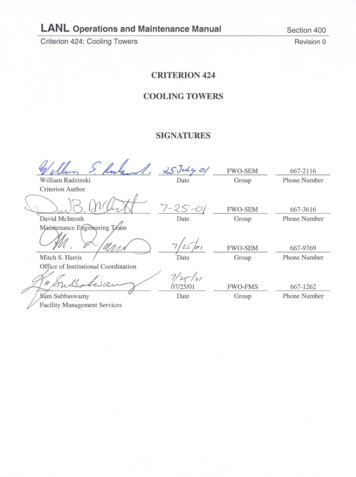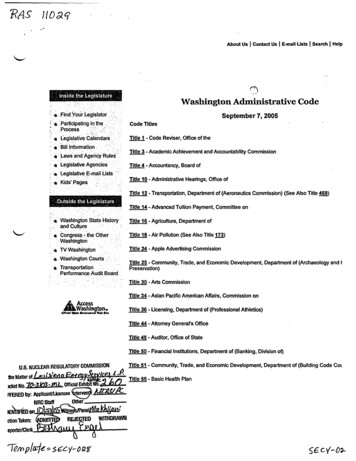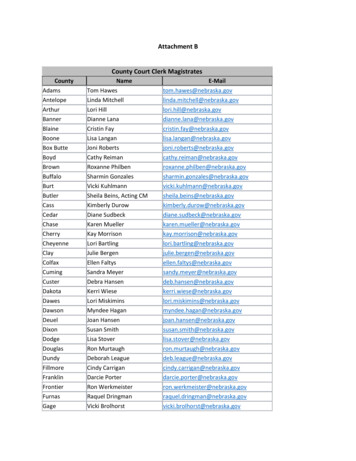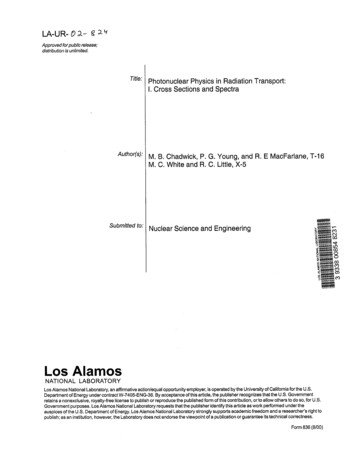
Transcription
Approvedfor public release;distributionis unlimited.Title: Photonuclear Physics in Radiation Transport:I. Cross Sections and SpectraA uthor(s): M. B. Chadwick, P. G. Young, and R. E MacFarlane, T-16M. C. White and R. C. Little, X-5Submitted to.Nuclear Science and EngineeringLos AlamosNAT I0 NA L LAB 0RAT0 RYLos Alamos National Laboratory,an affirmative actionlequal opportunity employer, is operated by the University of California for the US.Department of Energy under contract W-7405-ENG-36. By acceptance of this article, the publisher recognizes that the U S . Governmentretains a nonexclusive,royalty-freelicense to publish or reproduce the published form of this contribution, or to allow others to do so, for U.S.Government purposes. Los Alamos National Laboratory requests that the publisher identify this article as work performed under theauspices of the US. Department of Energy. Los Alamos National Laboratory strongly supports academic freedom and a researcher's right topublish: as an institution, however, the Laboratory does not endorse the viewpoint of a publication or guarantee its technical correctness.Form 836 (8100)
C-M6JL.t 6”VCL-I(Photonuclear physics in radiation transport:I. Cross sections and spectraM.B. Chadwick, P.G. Young, and R.E. MacFarlaneTheoretical Division, Uniuersity of California,Los Alamos National Laboratory, Los Alamos, N M 87545M.C. White and R.C. LittleX - Division, University of California,Los Alamos National Laboratory, Los Alamos, N M 87545AbstractWe describe model calculations and nuclear data evaluations of photonuclear reactions on isotopes of C, 0, Al, Si, Ca, Fe, Cu, Ta, W, and Pb, forincident photon energies up to 150 MeV. The calculations, using the GNASHcode, include Giant Dipole Resonance and quasideuteron models for photoabsorption. The emission of secondary particles and gamma-rays are computedusing preequilibrium theory, together with an open-ended sequence of compound nucleus decays using the Hauser-Feshbach theory. The accuracy of thecalculated and evaluated cross sections are assessed through extensive comparisons with measured cross sections, average neutron multiplicities, andenergy-dependent emission spectra. The evaluated ENDF files facilitate radiation transport studies of the importance of photonuclear reactions in a number of technologies including: photoneutrons produced in electron/photonaccelerators; shielding studies; and nondestructive detection of nuclear materials. In a subsequent back-to-back paper we describe developments to the1
MCNP and MCNPX codes to utilize these data in transport simulations.2
I. INTRODUCTIONPhotonuclear physics has, until recently, remained a strangely-neglected subject of studyin radiation transport computations. Evaluated nuclear data files (ENDF), such as the U.S.ENDF/B-VI cross section library [l],have not included evaluated photonuclear cross section data, and additionally radiation transport codes have not been developed to utilize suchENDF data except for certain ad-hoc studies [2,3]. Whilst it is true that photoneutrons typically provide only a small additional neutron source in technologies involving the nuclearforce (e.g. fission, fusion, and high-energy proton accelerator-driven spallation sources),photoneutrons are of significant importance in technologies involving electron acceleratorsand bremsstrahlung targets. In these cases, neutrons are produced primarily through thephotonuclear reaction process, afld can pose a serious concern for radiation protection andshielding. Of course, photonuclear reactions are also widely used as spallation neutronsources or physics experiments, such as the ORELA facility at Oak Ridge National Labo.ratory.We present two back-to-back papers describing work at Los Alamos National Laboratoryto develop a photonuclear capability in radiation transport simulations. This first paperdescribes our evaluation methods, including nuclear model calculations, used to produceevaluated cross section data files in the ENDF format. Results are presented for photonswith incident energies up to 150 MeV on twelve isotopes of the following elements: C, 0, AllSi, Ca, Fe, Cu, Tal W, and Pb. These represent some of the most important materials used inaccelerator components, collimators and beam-shaping devices, beam-stops, bremsstrahlungconversion targets, shielding, as well as elements abundant in human tissue. In the secondpaper, we describe extensions to the MCNP and MCNPX radiation transport codes to utilizethese photonuclear data in fully-coupled radiation transport calculations, The second paper[4] also includes some validation tests, as well as comparisons with integral experiments,to benchmark the new photonuclear capability. Earlier versions of this work have beenpublished in a conference proceedings [51.3
There ctre two principal reasons why photonuclear capabilities have not previously beenincluded in transport codes through use ofENDF files:(1) Experimental photonuclear datafrom different laboratories (e.g. data from the measurement programs at Livermore, Saclay,and Illinois) often show discrepancies that must be resolved in the evaluation procedure; and(2) ‘There are few measurements of the energy- and angle-dependent spectra of secondaryparticles emitted in photonuclear reactions. Most of the existing spectral measurements arefor bremsstrahlung photon sources, instead of for monoenergetic sources as required for acomplete cross section evaluation. Because a radiation transport code needs such energyspectra information, some of the most widely-used photonuclear data compilations, such asthose of Dietrich and Berman 161 and Varlamov et al.[?I,are not immediately usable in atransport context. The present work largely depends upon nuclear model calculations toestimate emission spectra, though these calculated spectra are consistently obtained togetherwith the calculated cross sections for various channels, e.9. (y, In), ( 7 ,2n), e t c . , that canbe validated through comparisons with measured values.A number of other researchers from laboratories in Japan (JAERI, Tokai), South Korea(KAERI, Taejon), Russia (IPPE, Obninsk and Moscow State University), China (CIAE,Beijing), and Brazil (University of Sao Paulo) are presently working on the development ofphotonuclear reaction cross section data for transport applications, under the coordination ofan International Atomic Energy Agency (IAEA) Coordinated Research Project (CRP), entitled “Compilation and Evaluation of Photonuclear Data for Applications” [8]. The presentwork is part of this effort, and a full suite of ENDF evaluations for over 160 isotopes will bereleased in 2000 on a compact disc (CD) together with documentation in an IAEA report[9]. The following photonuclear applications were of primary concern to this project: (a)Photoneutrons produced in medical electron accelerators used in cancer radiotherapy, forradiation protection and dosimetry applications, and the impact of photoneutrons and photoprotons on absorbed dose in the body; (b) Detection of nuclear materials ( e.g. actinides)using nondestructive remote detection of photoneutrons, or characteristic decay gammarays, following photonuclear reactions induced by photons produced by a compact electron4
accelerator or other sources; (c) Activation analyses for the production and transmutationof isotopes in a photon field; (d) Plasma diagnostics in fusion technologies; (e) Nuclearastrophysics, where photonuclear reactions play an important role in stellar nucleosynthesis.While this paper is the first work to present photonuclear reaction analyses in the EYDFformat, for use in radiation transport simulations, it is important to note that previous workshave included photonuclear reactions into transport simulation codes. These intranuclearcascade codes compute the photonuclear reactions “on the fly” during the simulation. Theworks of Alsmiller et al. [lo], Gabriel [ll],Fasso, Ferrari and Sala [12,13],and blokhov etal. [14] are particularly noteworthy. Our present approach has the advantage that one canaim to have the most accurate possible representation of the reactions, obtained from bothexperimental data and model calculations, in the ENDF file. (We note, though, that Fasso’sapproach [13] is also able to utilize experimental information). The intranuclear cascadecodes have historically had the advantage that they can be used to compute photonuclearreactions on any target material, whereas transport codes that use ENDF data files aredependent upon an evaluation existing for the materials of interest. But this advantageis no longer an issue - the present work describes just twelve ENDF files for high-prioritymaterials in accelerator technologies, but the aforementioned IAEA project will soon beissuing similar ENDF files for over 160 isotopes, which will be sufficient for essentially allapplications.‘This paper is organized as follows. Section I1 describes the nuclear models we use tocompute photonuclear cross sections within the GNASH code. This includes photoabsorption reaction mechanisms, as well as preequilibrium and equilibrium emission mechanisms.‘4 model for the angular distributions of the ejectiles is also provided. Some comparisonswith measured data are given to illustrate the physics involved. Section 111 summarizes theENDF formats we use to represent the cross section data, and describes developments thathave been made to the NJOY code, for processing the data into a form usable by radiationtransport simulation codes. Section IV presents our results, including descriptions of evaluation procedures, and shows figures of the important photonuclear cross sections compared5
with rneasured data for validation purposes. Our conclusions are given in Section It’.11. NUCLEAR MODEL CALCULATIONSIIA. Photoabsorption Model‘4 model of photonuclear reactions must account for the different nuclear reaction mechanisms involved in the initial photonuclear excitation process, and the subsequent decay ofthe excited nucleus by particle and gamma-ray emission. At low energies, below about 30MeV, the Giant-Dipole Resonance (GDR) is the dominant excitation mechanism, where acollective bulk oscillation of the neutrons against the protons occurs. At higher energies upto approximately 150 MeV, where the wavelength of the photon decreases, the phenomenological model of photoabsorption on a neutron-proton (quasi-deuteron (QD)), which has alarge dipole moment, becomes important.Models of photonuclear reactions typically begin with a determination of the photoabsorption cross section, and this can be done in one of two ways: (1) An evaluation basedon experimental data, if data exist; and (2) A model calculation of photoabsorption. Thesemethods are discussed in more detail below.If experimental data exist for the total photoabsorption cross section, they can be usedas input into most codes which model the subsequent particle emission reactions. The mostuseful type of experimental data here are from photon absorption experiments which measurethe total photoabsorption cross section. For heavy nuclei, compilations of photoneutrontotal cross section such as that of Dietrich and Berman [6] can be used to approximate thephotoabsorption cross sections, since contributions from photoproton reactions (and otherreactions producing complex charged particles) are suppressed by the Coulomb barrier.However, in light nuclei this approach cannot be used since the photoproton cross section isno longer small, and in some cases exceeds the photoneutron cross section.An alternative way to obtain the photoabsorption cross section is to calculate it theoret-6
ically as a sum of two components [15],discussed in more detail below.The GDR component,C T G D R ( C )is,given by a Lorentzian shape, with parameters de-scribing the total absorption of the giant dipole resonance. A relation to be used readswhere i 1 for spherical nuclei, and i 1 , 2 for deformed nuclei which can generally bebetter represented as a sum of two Lorentzians, one for each axis of deformation. E, is theposition of the GDR peak, I’i is the GDR width, andojis the peak of the resonance crosssection, or Lorentzian i.‘The QD component, a o ( f , ) is, taken from the model of Ref. [15], which uses a Levingertype theory.It relates the nuclear photoabsorption cross section to the experimentaldeuteron photodisintegration cross sectiongd(6,),Here, the Levinger parameter was derived to be L 6.5 [lS],and f ( e y ) is the Pauli-blockingto account for Pauli-blockingfunction, which reduces the free deuteron cross section o (E-,)of the excited neutron and proton by the nuclear medium. The experimental deuteronphotodisintegration cross section was parameterized asThe Pauli-blocking was derived to be a multidimensional integral whose solution could bewell appr,oximated in the energy range 20 - 140 MeV by the polynomial expressionf(c.,) 8.37:14 x- 9.8343 x 4.1222 x- 3.4762 x7 9.3537 x lO-’c;.(5)
In Ref. 1151 the Pauli-blocking function was not parameterized below 20 L[e\/’, where ittends to zero, or above 140 MeV, where it tends to unity. Still, as the contribution needsto be defined at ail energies considered, we use an exponential shape ! ( e 7 ) exp(-D/c.,)for energies below 20 MeV, and above 140 MeV, withD -73.3 for e7 20 MeV andD 24.2 for cy 140 MeV. This form has the correct behavior in that it tends to zero atcy :0, and unity for largeE?and is continuous with Eq. ( 5 ) a t 20 and 140 MeV.Photoabsorption calculations using the above model are common [16,17,12,18]. In somecases, authors have treated the Levinger parameter as an adjustable parameter to obtainbest agreement with measurements in the 50 - 150 MeV photon energy region.I?inally, we note a method sometimes used by evaluators to infer the total absorptioncross sections when no measured data exist, and when the absorption cross section cannotbe equated to measured photoneutron cross sections. This situation sometimes arises forlight nuclei. This method involves using a nuclear model calculation to estimate the ratio of.(y, m)to (7,abs) cross sections; and inferring the total absorption cross section (y, abs) suchthat the calculated (y,z n ) agrees with measurements. This procedure has been describedin model detail in Refs. [17,13].1I.B. Preequilibrium EmissionPreequilibrium reaction mechanisms become important for incident photon energiesabove 10-15 MeV. In the photoabsorption mechanisms described in the previous subsection, the initial nuclear excitation can be understood in terms of particle-hole excitations( l p l h for the GDR; 2p2h or 2 p l h , as discussed later, for QD processes) and thus it is naturalto use a preequilibrium theory of particle-hole excitations to describe the processes of preequilibrium emission, and damping to equilibrium, during the evolution of the reaction. Suchmodels can be used to calculate photonuclear reactions for incident photons with energiesup to about 150 MeV, which is just above the threshold for pion production.Semiclassical preequili brium models, such as the exciton and hybrid models, have proved
to be powerful tools for predicting particle emission spectra with a high degree of reliability.and in a computationally-fast manner [19,20,16,18]. Semiclassical models make use of detailed balance, and phase space considerations, to calculate emission rate probabilities fromparticle-hole states. By working in terms of emission rates, and not quantum mechanicaltransition amplitudes, some information is lost, particularly concerning observables sensitiveto interference effects such as angular distributions and analyzing powers. Additionally, suchmodels typically do not account for correlations in the particle-hole excitations. However,these deficiencies are to some extent compensated by the ease of implementation and highpredictive power of the semiclassical theories. Semiclassical Intranuclear Cascade (IYC) photonuclear models have also been developed [11,13,14].These models have much in commonwith preequilibrium models. They differ, though, by following the trajectories of the excitednucleons in coordinate and momentum space (semiclassical preequili brium models usuallyjust follow the excitations in energy space), and by assuming that free nucleon-nucleon scattering cross sections can be used for in-medium nucleon scatterings. In practice, it is onlythe semiclassical preequilibrium models that have been implemented for photonuclear reactions, and the quantum multistep preequilibrium models [21] have not yet been extendedfor calculating these processes.Two works in particular have demonstrated the usefulness of semiclassical preequilibriummodels in describing photonuclear reactions: Wu and Chang’s paper [19] on an excitonmodel; and Blann’s studies [20] using the hybrid model; both of which utilize a WeisskopfEwing evaporation theory to describe the subsequent equilibrium decay. Wu and Changused an initial 2p2h state in the preequilibrium cascade, while Blann argued that the twoholes are correlated through the QD mechanism, and therefore can be approximated as onedegree of freedom, i.e. a 2plh initial state. Also, calculations by Ryckbosch et al. [22]indicated a preference for an initial 2plh state when analyzing emission spectrum data at60 MeV.For the present work, the GNASH code has been developed to include a preequilibriumcascade following the excitation of particle-hole states in photoabsorption, using a master9
equation exciton model with an initial 2plh state. Additionally, multiple-preequilihriumemission processes, where more than one fast preequilibrium ejectile is emitted in the reaction, are included using the theory of Ref. [23]. For both primary and multiple preequilibrium emission, the neutron-proton distinguishability factors were modified to reflect theinitial particle-hole type appropriate for the Q D mechanism (ie. of the two particles, oneis a neutron and the other a proton).1I.C. Compound Nucleus Equilibrium EmissionFollowing the possible emission of preequilibrium particles, the remaining nuclear systemreaches equilibrium, after which it decays by sequential particle or gamma-ray emission untilthe residual nucleus ground state is reached.Generally, the calculation of these equilibrium decay processes do not present any particular theoretical difficulties. The Hauser-Feshbach theory is applied, which includes angularmornentum and parity conservation, and accounts for the fact that an El-photon brings inone unit of angular momentum. The principal uncertainty entering these calculations is inthe input information needed to compute equilibrium decay rates: nuclear level densities,optical model transmission coefficients and inverse reaction cross sections, and gamma-raystrength functions. The IAEA Reference Input Parameter Library (RIPL) [24] providesextensive guidance on the choice of these quantities. Additionally, we have been able to usemany of the input parameter sets developed for our analyses of neutron and proton inducedreactions on these same targets for the LA150 library [25].1I.D. Angular DistributionsA knowledge of the angular distribution of the ejectiles in photonuclear reactions isessential for radiation transport studies, but the GNASH code in its basic form yields onlyangle-integrated results. In nucleon-induced reactions, the Kalbach systematics [26] havebeen widely used for obtaining double-differential emission spectra. They are particularly10
attractive for use in evaluation work since for each emission energy one need only specify thepreequilibrium fraction ( f s for )the angular distribution to be defined, allowing a compactrepresentation of angle-energy correlated cross sections. However, as originally formulatedthey cannot be applied in photonuclear reactions. Ideally, for applications it would beuseful to parameterize measured angular distributions in monochromatic photon-inducedreactipns in the quasi-deuteron and giant dipole resonance (GDR) regimes, but an extensiveexperimental data set does not yet exist (larger amounts of experimental information existfor incident photons with a bremsstrahlung spectrum, but these data are not directly usable).Below we summarize an applications-oriented method [27] for determining continuumphotonuclear angular distributions for emission of light particles ( n ,p , d , t , 3He, and a ) forenergies up to 150 MeV. Based on theoretical considerations by Chadwick and Oblozinsky[23] for the angular forward-peaking in preequilibrium reactions, Kalbach’s 1988 angulardistribution systematics [26]for a neutron projectile are modified for use in photon-inducedreactions. This results in photonuclear angular distributions which are less forward-peakedthan their nucleon-induced counterparts in the quasideuteron regime, due to the small momentum carried by a photon. In the GDR regime, a simple approximation of isotropy isassumed.II. D.1 Giant-Dipole RegionAt present, no general prescription is available for nuclear data evaluators for describingthe angular distribution of secondary particles emitted in photonuclear reactions in the GDRregime. Experimental angular distributions for emitted nucleons from such collective excitations often show a dipole shape (peaking at 90-degrees), but nuclear structure effects areimportant in determining the detailed angular distribution and it is not clear that accuratesystematics can be developed to describe them.One of the main problems is that most measurements are for an incident bremsstrahlungspectrum, and not for monoenergetic photons. This is a problem because angular distributions are incident-energy dependent, and are also angle-energy correlated11(2.e., the angular
distribution varies for different secondary emission energies). Given this situation. two options appear available for evaluators:1, Include angular distribution information based on available measured data2. Assume isotropy in the GDR regime, for simplicityThe evaluations described in this paper follow the latter approach, except for carbon andoxygen where information from measurements is available and is used. I t is hoped that formost applications, this is a reasonable starting point, and hopefully future work will resultin a more accurate angular distribution representation within ENDF files.II. D.2 Quasideuteron RegionChadwick et al. [27] presented an approach for calculating the angular distribution ofsecondary ejectiles emitted in photonuclear reactions in the quasideuteron regime. Theapproach made use of the theoretical basis for the forward-peaking parameter “a’’ in theKalbach systematics (originally developed for nucleons) [16,28], which was found to be dependent upon the momentum of the projectile. The low momentum of photons, comparedto nucleons of the same energy, results in angular distributions which are much less forwardpeaked than their nucleon counterparts.‘This approach, which is presented below, allows evaluators to make use of the Kalbachsystematics developed for nucleon projectiles, with a straightforward modification to the“a” -parameter.II. U .3 Recommenced Systematics for Use an EvaluationsWe recommend the applications-oriented method (Ref. [27]) to calculate continuum angular distributions of light particles (n,p , d , t , 3He, and a ) produced in photonuclear reactionsbased on Kalbach’s 1988 systematics and the theoretical considerations given in Ref. [28].The procedure for obtaining photonuclear angular distributions for a photon of energy 5150 MeV in ( 7 , g ) reactions, where y may represent all light ejectiles with mass 5 4 , is:12
aDetermine the a” parameter for ( n , y ) reactions, for an incident neutron with energyE,,, from Kalbach’s 1988 systematics.Obtain the photon-projectile a using:where the a” parameter is taken from Kalbach’s 1988 paper [26] for an incident neutron of the same energy as the photon projectile. The first modification factor to a”accounts for the lower photon momentum compared to a neutron, while the secondfactor approximately accounts for differences in refraction effects, and an upper limit of4 for this correction to prevent it becoming unphysically large a t low emission energies 71.aApply this a value in the following formulae:where M S D ( E is)the fraction of the emission spectrum at emission energyEcomingfrom preequilibrium processes. An isotropic distribution for the non-precompoundcontribution is assumed. The quasideuteron angular distribution shape is given by:do) &a12a- e-a exp ( a cos 8).In the present work, the above angular distribution systematics are used as a samplingdistribution function in the MCNP and MCNPX Monte Carlo transport code (see Ref. [4]for more details). An attractive feature of the angular distribution Eq. (8) is that it canbe integrated analytically, so that angles can be sampled in a Monte Carlo approach usinga closed-form expression. The probability of a particle being scattered to an angle 8 isproportional to q(O)sin(@).To sample from this distribution, it must be integrated from8 0 to 8’ - the sampled value for 0 corresponds to the value of 8‘ for which the integral13
equals a raridorn number R chosen between zero and unity. This then gives a sampled thetaas:8’ arccos [In[exp(a)- R(exp(a) - exp( - a ) ) ] / a ] .(9)Therefore, to Monte Carlo sample the angular distribution Eq. ( 7 ) , two random numbersmust be chosen: (1) to determine whether an isotropic distribution (the first term in Eq. ( 7 ) )or a forward-peaked distribution (the second term in Eq. ( 7 ) )is to be used, dependent onwhether or not the random number is below the value of M s D ( E ) ;(2)to sample an isotropicdistribution, or a forward-peaked distribution using Eq. (9).I1.E. Illustrative Comparisons with ExperimentA difficulty in testing photonuclear reaction theories that model nucleon emission spectra is the lack of experimental data to compare the model predictions against. While photoneutron and photoproton emission spectra from bremsstrahlung photon sources are notuncommon, such measured spectra from monoenergetic (“monochromatic”) photon incident beams are sparse. A few monoenergetic photon-induced experiments do exist though[29,221, and in addition, quasi-monoenergetic photon-induced spectra have been inferredusing the difference-technique, where two bremsstrahlung-induced emission spectra, withdifferent end-points, are subtracted to approximate the spectrum due to a monoenergeticsource. These measurements are described in more detail below.One way to circumvent problems in validating emission spectra calculations given thelack of differential monoenergetic photon-induced measurements, is to test the theoreti-2n), etc), along withcal predictions of partial exclusive reaction channels (e.g. (y, In),(7,neutron emission multiplicities, against experimental measurement. These measurementsindirectly test the calculated emission spectra. This is because the energy-dependence ofthe calculated photon emission spectra strongly influences the exclusive reaction channelspopulated, by energy balance. An example is shown in Fig. 1, for photons incident on14
Lo8Pt).The GN.ASH calculation is seen to describe the partition of the absorption cross section amongst the (y,I n ) , (y,2n), (7,3n)channels well. This particular example illustratesanother difficulty that one faces when analyzing experimental measurements - discrepanciesbetween data measured at different laboratories. In this case we have adopted Berman’sview [30] that the data from Saclay should be renormalized down by 7 % and that the olderdata from Livermore should be renormalized up by 22%.As an illustrative example of the use of neutron emission multiplicities to test the modelcalculations, Fig. 2 shows calculated average multiplicities for neutron emission comparedwith the measurements of Lepretre et al. [31). There is a nice discussion in Lepretre’s paper[31] commenting on the slope of the average neutron multiplicity curve, which is worthrepeating: If preequilibrium emission did not occur, each emitted neutron would requireapproximately 10 MeV (separation energy plus evaporation kinetic energy), and so themultiplicity curve would increase at a slope of 1 unit for every 10 MeV incident energy. Thedata in Fig. 2 show such a steep slope at the lowest incident energies, but for higher energiesa much smaller slope occurs due to the higher kinetic energy carried by preequilibriumejectiles. These data, therefore serve to indirectly validate that calculated emission spectra.Figure 3 shows measured fast and slow multiplicities a t an incident photon energy of70 MeV [31], compared with calculations (shown for all energies up to 150 MeV). The fastmultiplicity refers to the preequilibrium particles, while the slow multiplicity refers to thecompound nucleus particles, and the calculations are seen to describe the correct partitioning of ejectiles among preequiIibrium and equilibrium emission, and between neutrons andprotons. These measurements are invaluable for testing the preequilibrium modeling in thecalculation, since direct measurements of the nucleon emission spectra from monoenergeticphotons do not exist for lead. The large Coulomb barrier in lead is responsible for the excessof fast preequilibrium neutrons compared to protons; a t the highest energies the differencesare reduced. In general the slow neutron multiplicity is much larger than the fast multiplicities, since preequilibrium decay accounts for a t most the first two emissions, with thesubsequent sequential particle decays coming from compound-nucleus emission.15
Figure 4 shows an example of calculated 60 !JeV proton emission spectra at 90-degreescompared with data [22], for the 40Ca(y,zp)reaction at 60 MeV. The angular variationwas obtained using the approach described above and in Refs. [16,27]. The calculatedphotoproton emission spectrum describes
One way to circumvent problems in validating emission spectra calculations given the lack of differential monoenergetic photon-induced measurements, is to test the theoreti- cal predictions of partial exclusive reaction channels (e.g. (y, In), (7, 2n), etc), along with neutron emission multiplicities, against experimental measurement.
